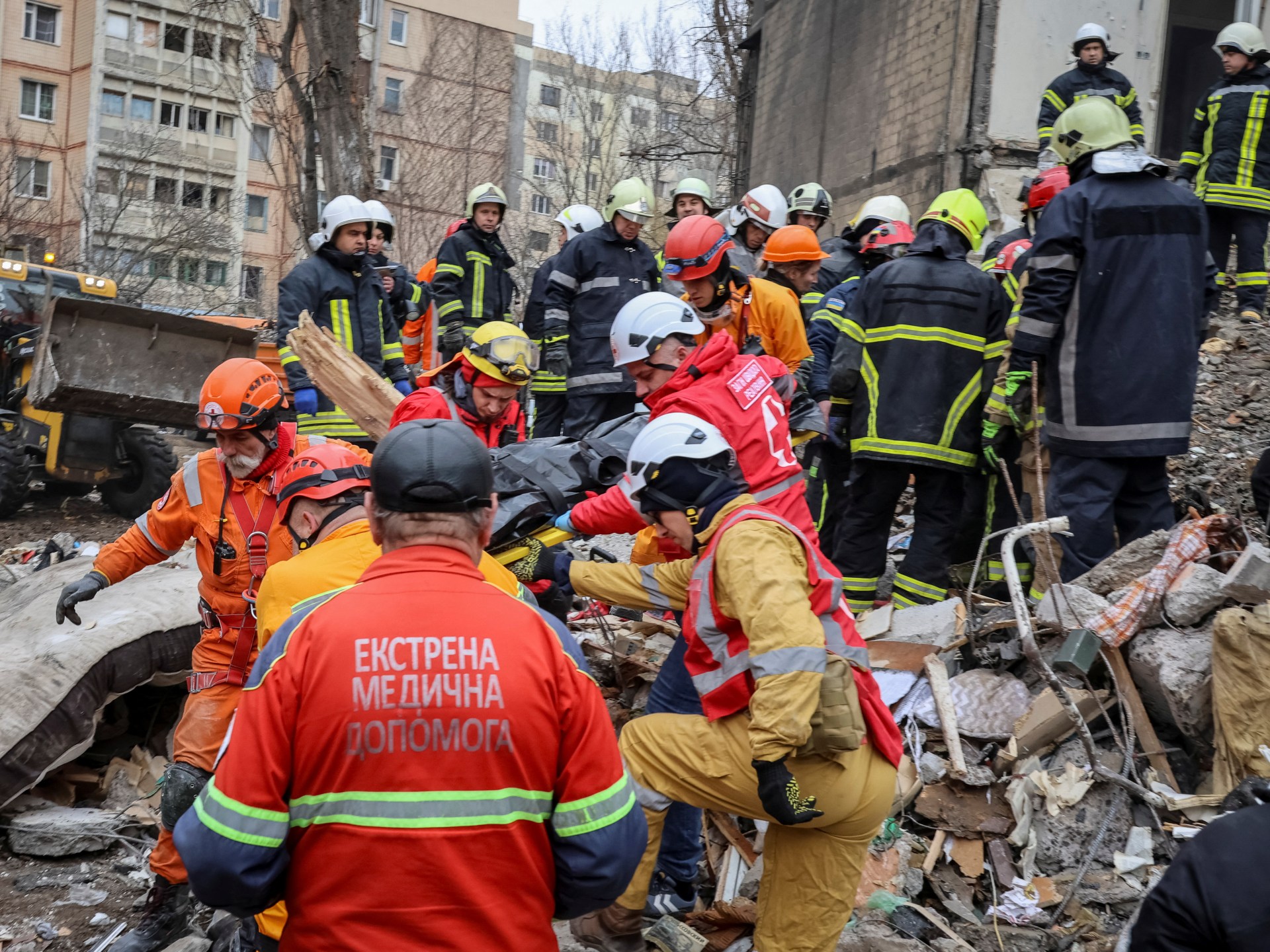Why did Bayesian yacht sink in 16 minutes?
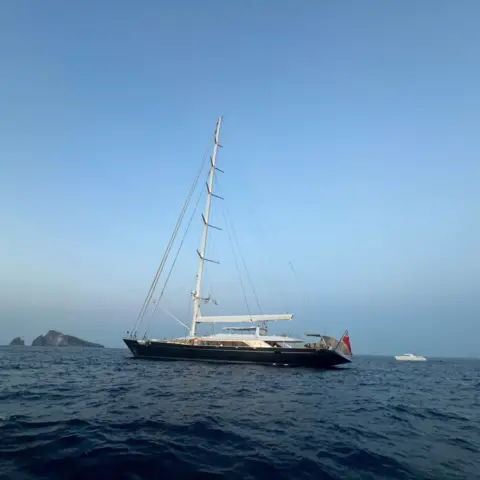 Mateo Brenninkmeijer
Mateo BrenninkmeijerUntil midnight last Sunday, Matteo Cannia was sitting out on a bench overlooking the sea in Porticello. It was too hot to sleep.
The 78-year-old, a fisherman since the age of 10, saw the first flashes of lightning. “I heard the thunder and the wind and decided to go home,” he told me.
“As the storm grew, everyone woke. Water was coming into my friend’s house.”
At about 04:15 local time, Fabio Cefalù – a fisherman who had been due to go out that wild Monday morning but, like others, decided against it – suddenly saw a flare go up.
He changed his mind and went out to sea to find out what was going on – and discovered only cushions and floating planks of wood.
A luxury super yacht called the Bayesian, moored only a few hundred metres away, had already sunk.
It all happened in a 16-minute window of disaster, chaos and torment, which catapulted a sleepy Sicilian fishing port to the centre of world news.
All but seven of the 22 passengers of the Bayesian had scrambled into a life raft as the yacht began to capsize. The others never made it out.
Charlotte Golunski, a British woman, was thrown into the water with her one-year-old daughter, Sophie. She told of clutching her baby in the air with all her strength to keep her from drowning. “It was all black around me,” she said, “and the only thing I could hear were the screams of others.”
She, her baby, and her husband James were among those rescued by a nearby sailing boat captain. Trapped inside the sinking Bayesian was her colleague Mike Lynch – one of the UK’s top tech entrepreneurs, dubbed “Britain’s Bill Gates”.
Luxury turned to terror
Mr Lynch had brought together family, friends and colleagues for an idyllic holiday on his luxury boat: a sumptuous 56-metre (184ft) sailing yacht that won design awards and had the world’s tallest aluminium mast.
In June, he was acquitted after a lengthy trial in the US on charges that he had fraudulently inflated the value of his company, Autonomy, before selling it to Hewlett Packard in 2011. The trip was planned as a celebration of freedom to mark his rehabilitation in public opinion.
Three days after the yacht went down, his body was retrieved by divers from the wreckage.
A day later, the body of his 18-year-old daughter Hannah, who was due to begin studying at the University of Oxford next month, was recovered.
 Reuters
ReutersAmong the others who died were the president of the investment bank Morgan Stanley, Jonathan Bloomer, and his wife Judy; Mr Lynch’s lawyer Chris Morvillo and his wife Neda; and the yacht’s chef, Recaldo Thomas. Mr Lynch’s wife, Angela Bacares, survived.
The family has released a statement talking of their “unspeakable grief”, adding they are “devastated and in shock”.
How the super yacht sank so quickly while other smaller vessels nearby survived the storm undamaged has dumbfounded experts.
In a press conference this weekend – the first public statement by officials since the disaster – local prosecutors said they had begun an investigation into potential crimes of manslaughter and negligent shipwreck.
The region’s state prosecutor Ambrogio Cartosio told reporters that while the probe was at a very early stage and nobody specific was being investigated, there were “many possibilities for culpability. It could be just the captain. It could be the whole crew… we are absolutely not ruling anything out”.
A small team of British marine investigators has also been sent to Sicily to work with their Italian counterparts.
Prosecutors said that they now believed a downburst was the weather phenomenon that hit the ship: a localised, powerful wind that descends from a thunderstorm and spreads unpredictably.
That contradicted previous reports that had identified the cause as a waterspout, or mini tornado at sea.
Either way, it’s clear extreme weather played a major role.
The crucial 16-minute window
 AFP
AFPMuch of the focus for the investigation team is of course on the conduct of the captain, 51-year-old James Cutfield from New Zealand. He survived, along with eight of his crew, and is being questioned.
“We didn’t see it coming,” he told Italian media, alluding to the storm, in his only public comment so far.
The problem is: plenty of others did. Violent winds and rain were forecast, following days of searing heat. The head of the company that built the Bayesian, Giovanni Costantino, told me he was convinced there had been a litany of errors on board.
“At the back of the boat, a hatch must have been left open,” he said, “but also perhaps a side entrance for water to have poured inside.
“Before the storm, the captain should have closed every opening, lifted anchor, turned on the engine, pointed into the wind and lowered the keel.”
A keel is a large, fin-like part of the boat that protrudes from its base.
“That would have stabilised the vessel, they would have been able to traverse the storm and continue their cruise in comfort,” he said.
Rescuers instead found the wreckage of the Bayesian 50 metres underwater with its almost 10-metre-long keel raised.
Had it been deployed, it could have helped counter the wind buffeting the Bayesian’s 75-metre high aluminium mast and kept the ship stable. But without it, experts told the newspaper La Repubblica that gusts of 100 kilometres an hour (62mph) would have been enough to capsize the ship – and Monday’s storm far exceeded that.
“The Bayesian was a model for many other vessels because of its stability and exceptionally high performance,” Mr Costantino said. “There was absolutely no problem with it. If water hadn’t surged in, it was unsinkable.”
He told me there were 16 minutes between the power going out on the ship at 03:56 – showing that water was flooding areas with electrical circuits – and the GPS signal being lost, indicating the moment it sank.
That period, along with any measures taken to mitigate the extreme weather, will be pored over by investigators, particularly once they locate the vessel’s black box recorder.
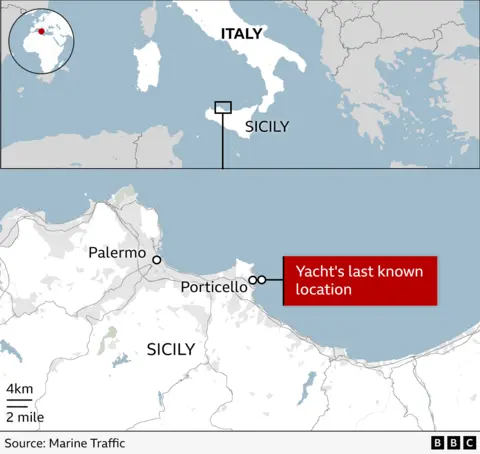
Rino Casilli, one of Sicily’s top ship surveyors, similarly believes that errors may have made the yacht vulnerable to the extreme weather.
“There should have been two members of the crew taking turns to be on watch overnight, given the storm warning,” he told me as he took me out on his boat – around a third of the size of the Bayesian. “And it should have been moored in the harbour, not out at sea.”
It has not yet been established how many people, if any, were on watch that night.
From his sailing boat, we gained rare access to the spot where the Bayesian went down.
Around us, an Italian police vessel circulated, warning us back. Suddenly, there was a flurry of activity among divers, as other rescue vessels arrived.
We didn’t know at the time – but they had just located more bodies.
It was an intensely challenging operation for the teams to recover those trapped in the wreckage. Given its depth, at 50 metres underwater, each diver was allowed 10 minutes down before resurfacing for their safety – 120 dives in total. They were assisted by remote control vehicles that could operate on the seabed for far longer.
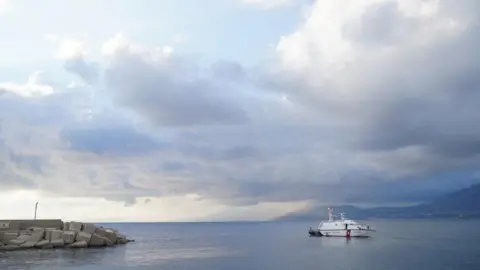 PA Media
PA MediaIn this weekend’s press conference, rescuers said the passengers trapped inside during the sinking took refuge in cabins on the ship’s left side, where the last air bubbles formed.
Five of the bodies were found in the first cabin on the left, they said, while the last body – confirmed as Hannah Lynch – was in the third cabin on the left side.
Access for the emergency teams was extremely difficult since the yacht remained largely intact with its furniture obstructing entry.
The coastguard compared it to an “18-storey building full of water”. When Ms Lynch’s body was brought ashore emergency workers on the port applauded their colleagues.
All seven of the dead have been transported to a mortuary for post-mortems.
Rescuers will now need to decide whether – and how – to salvage the wreckage, which would undoubtedly offer vital clues as to what happened. But bringing the Bayesian to the surface could take six to eight weeks and cost 15 million euros (£12.7m) by some estimates.
The hunt for clarity
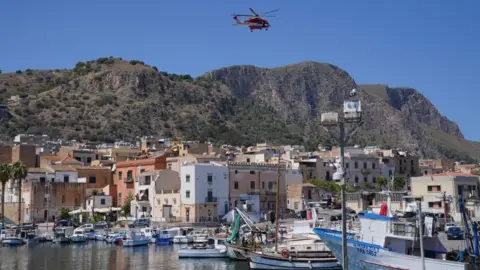 PA Media
PA MediaWhile the divers’ painstaking work to recover the dead has ended, the investigators’ painful hunt for answers has only begun.
They and the survivors are hunkered down in a hotel close to Porticello, which is strictly off-limits to journalists. Security guards promptly asked us to leave.
Solving the enigma of what happened to the Bayesian will be crucial not only to help loved ones of the victims reach some sort of closure, but also for the maritime industry to draw conclusions.
The brother of James Cutfield, the captain, said he was a “well-respected” sailor who had worked on boats his whole life. Did the experienced sailor somehow make a series of catastrophic errors? The trade union Nautilus, which represents seafarers and captains, called for restraint in passing judgement on the Bayesian’s crew.
“Any attempt to question their conduct without the full facts is not only unfair but also harmful to the process of uncovering the truth and learning any lessons from this tragedy,” it said.
The world’s media has begun to leave Porticello, which is gradually returning to the tranquillity of its pre-Bayesian era. Stray cats roam among the old fishing boats, and children play as their families eat out at the few seaside restaurants.
But what has happened over the past week has stunned and scarred many here.
“Last Sunday night, we saw the end of the world in Porticello,” said resident Maria Vizzo. “We’ve never seen something like this. Everyone here is shocked – and everyone is crying.”
Check out our Latest News and Follow us at Facebook
Original Source





